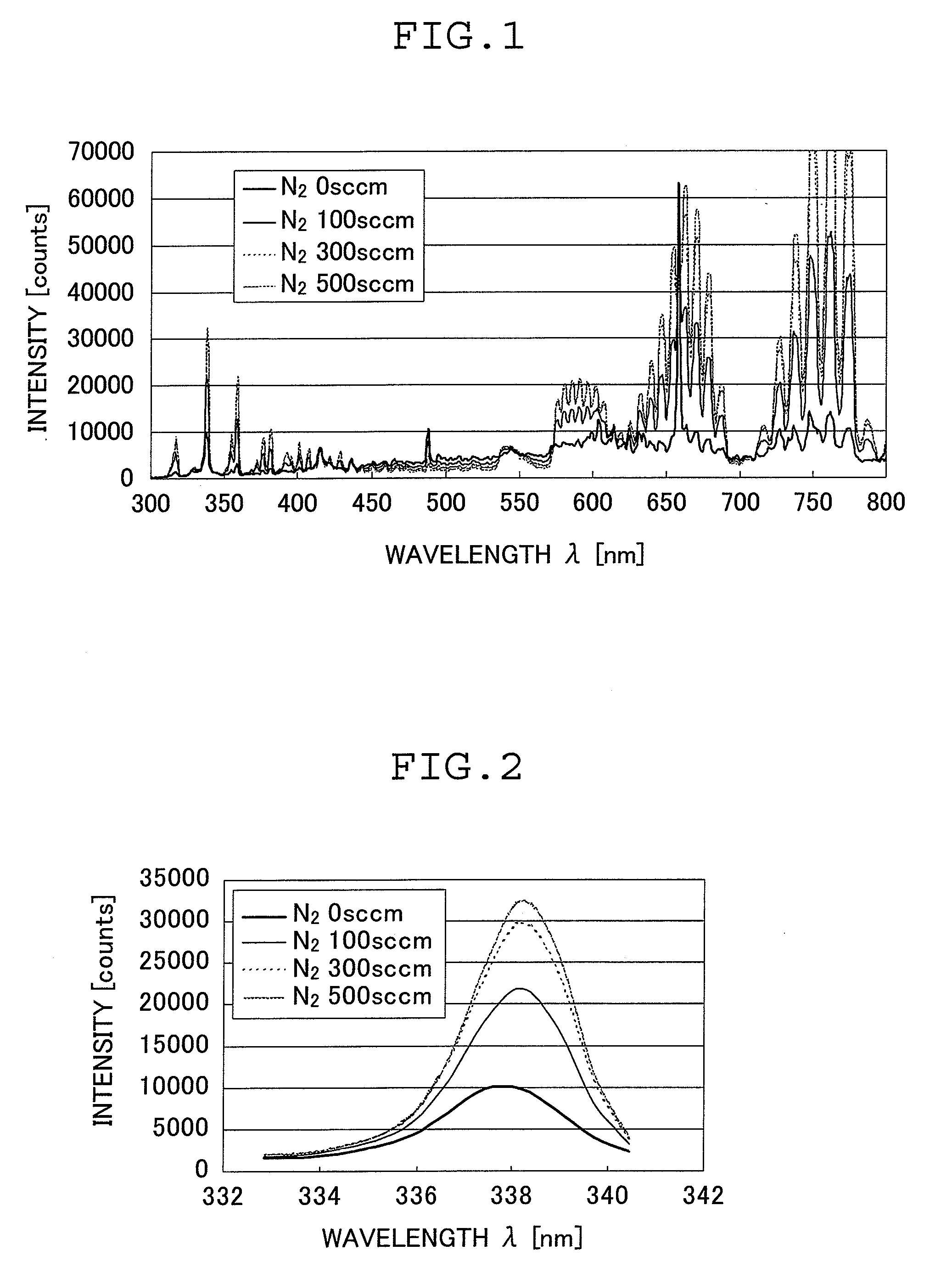Method of forming silicon nitride films
a technology of silicon nitride and film, which is applied in the direction of plasma technique, metal material coating process, coating, etc., can solve the problems of low film deposition rate of silicon nitride film-forming method, impede efficient production, and not achieve high enough film deposition ra
- Summary
- Abstract
- Description
- Claims
- Application Information
AI Technical Summary
Benefits of technology
Problems solved by technology
Method used
Image
Examples
example 1
[0083]A common CVD device based on an ICP-CVD process was used to form a silicon nitride film on a substrate.
[0084]The substrate used was a polyester film with a thickness of 188 μm (polyethylene terephthalate film “Luminice” manufactured by Toray Advanced Film Co., Ltd.).
[0085]The substrate was set at a predetermined position within a vacuum chamber, and the vacuum chamber was closed.
[0086]Then, the vacuum chamber was evacuated to reduce the internal pressure. When the internal pressure had reached 7×10−4 Pa, silane gas, ammonia gas and nitrogen gas were introduced into the vacuum chamber. The silane gas and the ammonia gas were introduced at flow rates of 50 sccm and 150 sccm, respectively (total flow rate: 200 sccm).
[0087]Evacuation of the vacuum chamber was adjusted so that the vacuum chamber had an internal pressure of 3 Pa.
[0088]Then, 2 kW RF power was supplied to an induction coil and a silicon nitride film was formed on the surface of the substrate by ICP-CVD. During the fil...
example 2
[0092]Example 1 was repeated except that the silane gas and the ammonia gas were introduced at flow rates of 15 sccm and 45 sccm, respectively (at a total flow rate of 60 sccm) to thereby determine the relation between the nitrogen gas flow rate and the film deposition rate.
[0093]It should be noted that the nitrogen gas was introduced at flow rates of 0 sccm and 100 sccm (the nitrogen gas flow rate being about 1.67 times the total flow rate of the silane gas and the ammonia gas), respectively.
[0094]The flow rate is shown in FIG. 4 and the film deposition rate at a nitrogen gas flow rate of 100 sccm with respect to the nitrogen gas flow rate of 0 sccm taken as 100% is shown in FIG. 5.
[0095]As is seen from FIGS. 4 and 5, by forming a silicon nitride film through ICP-CVD using the gas material including the silane gas, ammonia gas and nitrogen gas, the film deposition rate can be considerably improved compared with cases where no nitrogen gas is used.
[0096]In the case where the total f...
PUM
| Property | Measurement | Unit |
|---|---|---|
| temperature | aaaaa | aaaaa |
| pressure | aaaaa | aaaaa |
| temperature | aaaaa | aaaaa |
Abstract
Description
Claims
Application Information
 Login to View More
Login to View More - R&D
- Intellectual Property
- Life Sciences
- Materials
- Tech Scout
- Unparalleled Data Quality
- Higher Quality Content
- 60% Fewer Hallucinations
Browse by: Latest US Patents, China's latest patents, Technical Efficacy Thesaurus, Application Domain, Technology Topic, Popular Technical Reports.
© 2025 PatSnap. All rights reserved.Legal|Privacy policy|Modern Slavery Act Transparency Statement|Sitemap|About US| Contact US: help@patsnap.com



